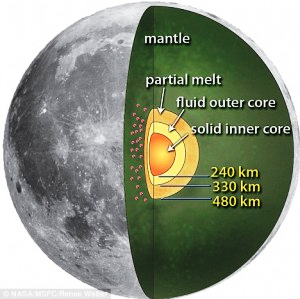
Today’s advanced equipment, and new analytical techniques, mean this data can now be reanalysed. Dr Renee Weber, a NASA scientist, used array processing as well as applying a stacking sequence to the 40 year-old data to remove the noise and pick out the strongest signals from 38 deep moonquakes. They found the Moon has a solid inner, iron-rich core 240km in diameter, and a liquid iron outer core, which is still fluid after 4.5 billion years. However our satellite also contains a partially melted section that our own planet is missing, comprising large lumps of solid rock and magma.
Weber understands this new discovery is an integral piece in the jigsaw of lunar origin, "if we have any hope of determining once and for all how the moon formed then we need to understand its structure completely." This new insight proves that the internal moon structure is more Earthlike than previously appreciated, and that the moon originally had a magnetic field of its own. Out of four current hypotheses of Moon creation, this new evidence gives more support to the GIT, which holds that a Mars-sized object collided with the early Earth .
Reference
- Renee C. Weber, Pei-Ying Lin, Edward J. Garnero, Quentin Williams, and Philippe Lognonne Science 1199375Published online 6 January 2011 [DOI:10.1126/science.1199375]